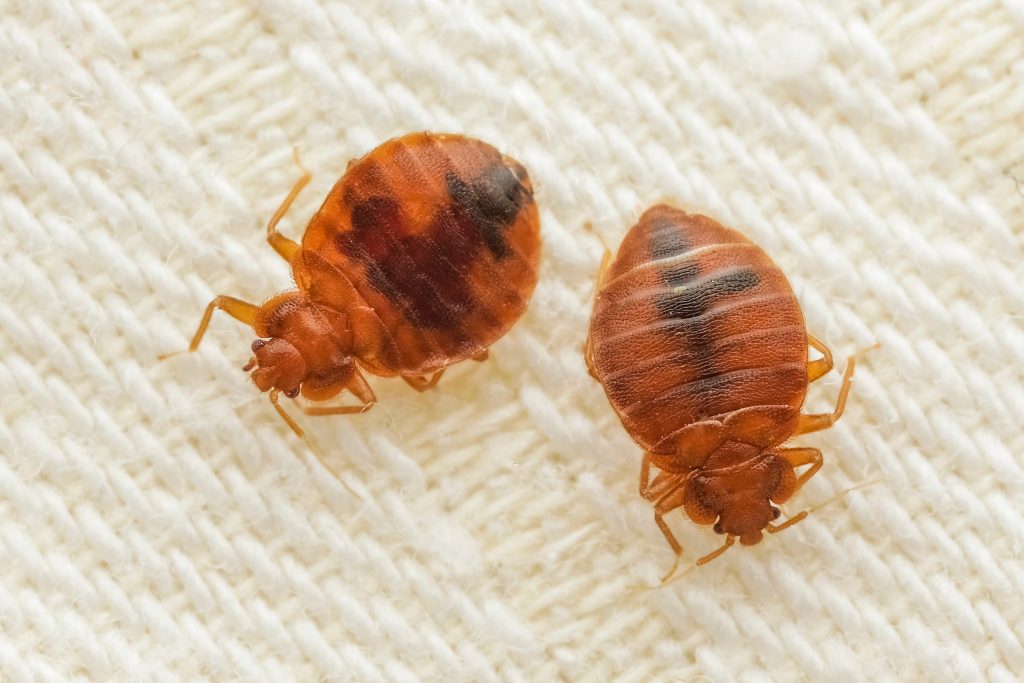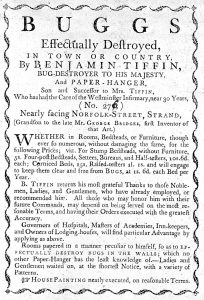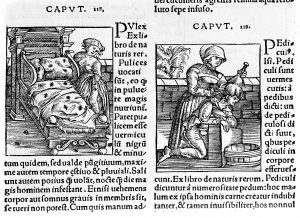
Banishing Bedbugs in the Early Modern World
Amidst the swirling panic about a surge in bedbug infestations in France and the UK, and the various articles instructing worried travellers on how to prevent or get rid of the insects, have you ever wondered how people dealt with these pesty critters in the past? The ‘Sleeping Well’ team have long been interested in the history of bedbugs and the herbal and chemical remedies that early modern people devised in order to get a good night’s rest.
The historian Lisa T. Sarasohn notes that it was not until the eighteenth century that people started to vocally fear bedbugs, although they had long been part of people’s lives and beds (Sarasohn 2013, 1). On the 12 June 1668, the seventeenth century mercantilist Samuel Pepys wrote in his diary how when travelling he and a companion had woken to find the beds ‘lousy’ [full of lice] which rather than causing disgust made him and his friend ‘merry’ in jesting about who had been more thoroughly bitten. Early modern people used the terms ‘lice’ and ‘fleas’ interchangeably to refer to what we would now call fleas, head lice, bedbugs and wood lice. Bedbugs in this earlier period appear to have been seen as a mild annoyance and something that affected people from all levels of society. In the eighteenth century however, bedbugs were perceived to be increasing in number and virulence and were greatly feared. Their troublesome itchy bites, tenacity to survive most attempts to exterminate them and noxious smell became a considerable concern particularly for the emerging middle class living in urban centres like London. The proliferation of bedbugs was blamed almost exclusively on travel and trade with the new world and increasingly linked with poverty and cramped living conditions. An enterprising group of individuals took advantage of this moral panic and branded themselves as professional exterminators.

Bug-Destroyer: eighteenth-century trade card. Wellcome Collection. Source: Wellcome Collection.
But for those who could not or did not want to fork out the money for a professional to come and ‘destroy bugs’, there were a multitude of remedies in printed guides of the period. The author of The Vermin Killer (1680) suggested mixing tar with wild cucumber, letting it stand for one or two days and then ‘anoint the bedstids [bedsteads] with it, and all the Buggs will die’. John Southall, a professional exterminator, wrote perhaps the most famous guide to getting rid of bedbugs inspired by a trip to Jamaica where he encountered a plethora of ‘That Nauseous Venomous Insect[s]’. A freed black slave offered him an insecticide which he then went on to include in his Treatise of Buggs (1730).
Another popular guide, also called The Vermin Killer (1755), contained upwards of twenty recipes that can be grouped into four broad categories: anointing, fumigating, luring/trapping and repelling. The first kind of remedy, anointing, involved rubbing the bedstead with a mixture normally containing a relatively caustic chemical. Take, for example, a concoction of the powder of squills (a plant of the lily family) and wine vinegar which was to be sponged on to the bedframe. Other kinds of herbal, chemical and animal products might similarly be placed underneath or on furniture and bedding to poison the bugs like ‘unslack’d lime’; rabbit guts; glue and vinegar; soap and boiled onions; rue, wormwood and sheep’s suet; and green wallnuts with coloquintida seeds. To fumigate a room, one might place gun powder or a dish of guinea pepper (a spice from west Africa), set it on fire, shut the doors and windows and suffocate the bugs. Another kind of remedy lured the bugs out of their holes to allow them to be captured and killed. By burning brimstone under the bed ‘they’ll come out presently, that you may kill them.’ Similarly, setting ‘a Trap about a yard and a half long’ made of wicker that one could buy from basket makers would encourage the bugs to ‘creep into it’ where you could promptly kill them in the morning. Bugs would be repelled by hanging a bear’s skin in your room – presumably the sight was thought to frighten them into moving elsewhere. Placing bags of wormwood ‘between your bed and sacking [bedding]’ would similarly stop the insects from making themselves at home in mattresses. Bugs were thought to be particularly rife in summer and thus all of these remedies were to be performed more regularly during the hot season.

Hortus sanitatis. Latin. 1536. n 93074319. Wellcome Collection. Source: Wellcome Collection.
Domestic recipe books – that is handwritten books that families often collaboratively compiled – contain a number of remedies for bedbugs that share many of these practices, particularly anointing or sprinkling beds, bedframes and other furniture. Andrew Slee, a fellow of Peterhouse, Cambridge from 1650-1656, described how combining fortified wine with camphire and then use a sponge or brush to thoroughly wet the bed and furniture ‘wherein those vermin harbour and breed’ would ‘infallibly kill & destroy them & their nits should they swarm ever so much’. If the bugs were so active that you could see them crawling around, Slee suggested simply dropping some directly onto the body of a critter. The mixture was flammable, and therefore he warned not to undertake the procedure at nighttime when there would have been numerous candles to illuminate one’s work. Perhaps most usefully its scent was ‘very wholesome, & to many people agreeable’. This would have been welcome given the prevailing disgust associated with the smell of bedbugs (V.a.398, 101). An anonymously compiled recipe book from 1715 contains a ‘Bug wash’ that used turpentine, quicksilver and gall (a knob or outgrowth coming out of a tree, in this case, unspecified) boiled together and used hot on the bedstead. Usefully the owner also copied out a remedy for ‘the Itch’ to be used ‘when you go to bed’ (Ms Codex 753). These kinds of overlapping complementary remedies point to a rich culture of experimenting and implementing with herbal, chemical and animal materials in order to sleep well.
Mary Bridges Beck, the member of a prominent Bristolian Quaker family, suggested using caper bush with water and ‘wash the rooms with it’ and to be careful not to get it on your hands. This had been used successfully when the ‘spinning school’ became infested with bedbugs in 1760 (MS Codex 2004, 117). Another anonymous eighteenth century recipe book suggested boiling coleus plant from India with spring water and putting it ‘whare [where] the bugs resort’, which had been taken from a Mr Kendall (Ms Codex 780, 117r). The Lambton family receipt book from the 1750s, like Slee, suggested camphire and turpentine, but also noted that ‘scalding hot’ water with lavender would be an effective and ‘Cheaper’ remedy for those who could not afford pricier chemicals (MS 3151).
There is substantial evidence to suggest that bedbugs, like today, were a particular nuisance while travelling. When the Quaker missionary Ann Warder travelled to Philadelphia in the 1700s from her home in Ipswich, England, she recorded in her diary that the first night in New York she and her party had ‘rested well in a clean white bed’ without hangings ‘Since in N.Y. everybody was taking them down to prevent bugs, which otherwise would be very plentyfull here in hot weather’ (MC 975.01.082, 79). The writer Thomas Tryon in his Treatise of Cleanness (1682) noted that Italy, New England, Holland, Barbados and Jamaica were particularly rife with bedbugs, whilst John Southall said that in 1730 the insects abounded ‘in all foreign places, especially in hotter Climates’ and that trading ships ‘are so over-run with them’. He noted that seaports in England were often troubled with the insects, whereas inland towns had never even heard of bedbugs. Indeed, in January 1734 the Royal Navy yacht Charlotte’s state room was painted green by a Mr Turner with plans to paint all the sleeping areas of the boat the same colour in the hopes this might deter a rampant invasion of bedbugs (ADM 106/855/3). The captain of another navy boat, the Henrietta, kept at Deptford in London, ‘pulled down’ all cabins on board to clear bugs that were afflicting soldiers sorely (ADM 106/576/150).
Like today, early modern people were keen not to bring bedbugs home when they travelled and took considerable pains to exterminate them when they had set up shop in their sleeping quarters. Such practices which drew on a variety of herbal, chemical and animal ingredients reveal the ways in which people sought to create restful and peaceful environments to aid sleep in the past, as well as the ways in which homes have always contained a mixture of human and non-human members, even if some are perceived as unwanted. Domestic recipe books show that people gathered, systematised and tested various means to rid their beds and homes of bedbugs that might be termed ‘environmental technologies.’ Materially and conceptually people sought to transform beds and chambers into hospitable places for humans and inhospitable for bugs and other vermin.
References:
Anonymous. 1755. The Vermin-killer: Being a compleat and necessary family-book, shewing a ready way to destroy adders, badgers, birds of all sorts, earwigs, caterpillars, flies, fish, foxes, frogs, gnats, mice, otters, pismires, pole-cats, rabbets, rats, snakes, scorpions, snails, spiders, toads, wasps, weasles, wants or moles, worms in houses and gardens, bugs, lice, fleas, &c. London.
ADM 106/855/3. 1734. Records of the Admiralty, Naval Forces, Royal Marines, Coastguard, and related bodies. National Archives.
ADM 106/576/150. 1703. Records of the Admiralty, Naval Forces, Royal Marines, Coastguard, and related bodies. National Archives.
MC 975.01.082. 1786-1789. ‘Diary of Ann Warder’, Haverford College Quaker Collection.
Ms Codex 753. 1715. ‘Recipe book, account book, and notebook’, University of Pennsylvania Library. [unfoliated]
Ms Codex 780. 1739-1741. ‘Recipe book’, University of Pennsylvania Library.
MS Codex 2004. 1737-1799. ‘Commonplace book of Mary Bridges Beck’, University of Pennsylvania Library.
MS 3151, 1750. ‘Lambton family receipts’, Wellcome Library, London. [unfoliated]
Pepys, Samuel. 1893. The Diary of Samuel Pepys, ed. Henry B. Wheatley. London: George Bell & Sons.
Sarasohn, Lisa T. 2013.'”That Nauseous Venomous Insect:” Bedbugs in Early Modern England.’ Eighteenth-century studies 46.4: 513–530.
Southall, John. 1730. A Treatise of Bugs: shewing How they were first brought into England. London.
Tryon, Thomas. 1682. Treatise of Cleanness in meats and drinks of the preparation of food, the excellency of good airs and the benefits of clean sweet beds also of the generation of bugs and their cure. London.
V.a.398. 1654. ‘Andrew Slee medicinal recipes’, Folger Shakespeare Library, Washington D.C.
W.W. 1680. The Vermin-killer, Being a Very Necessary Family-book, Containing Exact Rules and Directions for the Artificial Killing and Destroying of All Manner of Vermin. London.








0 Comments